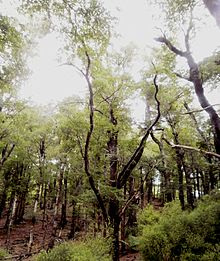- Nothofagus fusca
-
Nothofagus fusca 
Scientific classification Kingdom: Plantae (unranked): Angiosperms (unranked): Eudicots (unranked): Rosids Order: Fagales Family: Nothofagaceae Genus: Nothofagus Species: N. fusca Binomial name Nothofagus fusca
(Hook.f.) Oerst.Nothofagus fusca (New Zealand Red Beech) is a species of Nothofagus, endemic to New Zealand, where it occurs on both the North Island and South Island. Generally it is found on lower hills and inland valley floors where soil is fertile and well drained.[1]
It is a medium-sized evergreen tree growing to 35 m tall. The leaves are alternately arranged, broad ovoid, 2 to 4 cm long and 1.5 to 3 cm broad, the margin distinctively double-toothed with each lobe bearing two teeth. The fruit is a small cupule containing three seeds.
Pollen from the tree was found near the Antarctic Peninsula showing that it formerly grew in Antarctica since the Eocene period.[2]
Uses
Red Beech is the only known plant source, apart from Rooibos (Aspalathus linearis), of the C-linked dihydrochalcone glycoside nothofagin.[3][4]
It is also grown as an ornamental tree in regions with a mild oceanic climate due to its attractive leaf shape. It has been planted in Scotland[5] and the North Coast of the Pacific of the United States[6]. The red beech's wood is the most durable of all the New Zealand beeches[7] it was often used in flooring in many parts of New Zealand. The timber is exceptionally stable when dried to appropriate moisture values. The average density of red beech at 12 percent moisture content is 630 kilograms per cubic metre.[8]
 Red beech flooring in Nelson, New Zealand
Red beech flooring in Nelson, New Zealand
References
- ^ "Beech forest". Department of Conservation. http://www.doc.govt.nz/conservation/native-plants/beech-forest/. Retrieved 2010-04-28.
- ^ Rice University (27 June 2011). "Fossilized pollen reveals climate history of northern Antarctica". Physorg. http://www.physorg.com/news/2011-06-fossilized-pollen-reveals-climate-history.html. Retrieved 28 June 2011.
- ^ Hillis W, Inoue T (1967). "The polyphenols of Nothofagus species - II. The heartwood of Nothofagus fusca". Phytochemistry 6: 59–67. doi:10.1016/0031-9422(67)85008-8.
- ^ Bramati L et al. (2002). "Quantitative Characterization of Flavonoid Compounds in Rooibos Tea (Aspalathus Linearis) by LC-UV/DAD". Journal of Agricultural and Food Chemistry (Elsevier) 50 (20): 5513–5519. doi:10.1021/jf025697h. PMID 12236672.
- ^ "Planted and required trees in the Gardens of The Grange, Edinburgh, Scotland". The Grange Association. http://www.grangeassociation.org/product/100.pdf. Retrieved 2009-06-18.
- ^ "Nothofagus fusca in Washington Park Arboretum". Seattle Government. http://www.seattle.gov/parks/proparks/projects/ArboretumReport.pdf. Retrieved 2009-06-18.
- ^ Salmon, J.T. (1993). The Native Trees of New Zealand. Auckland, New Zealand: Reed Books. ISBN 0790005581.
- ^ Clifton, Norman (1990). New Zealand Timbers. Exotic and Indigenous. The complete guide. Upper Hutt, New Zealand: Wright & Carman Ltd..
External links
Australasia N. baumanniae • N. cunninghamii • N. discoidea • N. fusca • N. gunnii • N. menziesii • N. moorei • N. nuda • N. solandri • N. stylosa • N. truncata • N. womersleyiSouth America N. alessandri • N. alpina • N. antarctica • N. betuloides • N. dombeyi • N. glauca • N. nitida • N. obliqua • N. pumilioCategories:- Nothofagaceae
- Endemic flora of New Zealand
- Trees of New Zealand
- Trees of mild maritime climate
- Garden plants of New Zealand
- Ornamental trees
- Fagales stubs
- New Zealand plant stubs
- Tree stubs
Wikimedia Foundation. 2010.

